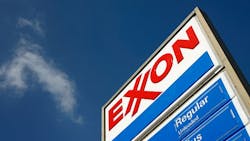Exxon Delivers Refining 'Shocker' With Worst Loss in 17 Years
Exxon Mobil Corp.’s refining business posted its poorest performance in 17 years, eroding first-quarter profit and casting doubt on the strength of the oil titan’s comeback from its annus horribilis in 2018.
The company’s fuel-making plants lost $256 million during the January-to-March period -- an average of almost $3 million a day -- as hefty stockpiles of gasoline squeezed margins and extensive repairs and mechanical overhauls slowed output. Exxon’s chemicals business also disappointed investors with a 49% slump in profit.
Exxon appeared to be “turning a corner,” RBC Capital Markets analyst Biraj Borkhataria said in a note to clients titled ‘A downstream shocker.’ “Clearly, the corner is further away than we expected, and we expect this to lead to underperformance in the near term.”
The shares slumped as much as 3.4%. The weak showing in Exxon’s refining and chemicals units overshadowed booming crude output from wells in the Permian Basin of West Texas and New Mexico. Daily, worldwide production increased 2.4% to the equivalent of 3.98 million barrels from a year earlier, aided by an almost 140% surge in Permian output.
Per-share earnings were 55 cents, compared with the average estimate of 72 cents in a Bloomberg survey of analysts. The last time Exxon’s refineries lost money was 2009 and the first-quarter showing was the worst in data going back to 2001.
Prior to Friday’s announcement, Wall Street expectations for Exxon had been brightening as the oil giant attempted to rebound from a disastrous first half of 2018, during which oil and gas production reached the lowest in a decade.
Exxon is the least-loved of the supermajor oil stocks, with just 30% of analysts who follow the company recommending investors buy. France’s Total SA is top of the list with 84% of analysts urging buy, followed by Chevron Corp., BP Plc and Royal Dutch Shell Plc. Of all of those, Exxon is the only one below the 50% mark.
Chevron also reported weaker refining results on Friday: earnings in the business fell 65% to $252 million from a year earlier. The California-based oil giant cited lower margins on fuel sales and inclement weather at West Coast refineries.
By Kevin Crowley and Joe Carroll
About the Author
Bloomberg
Licensed content from Bloomberg, copyright 2016.
